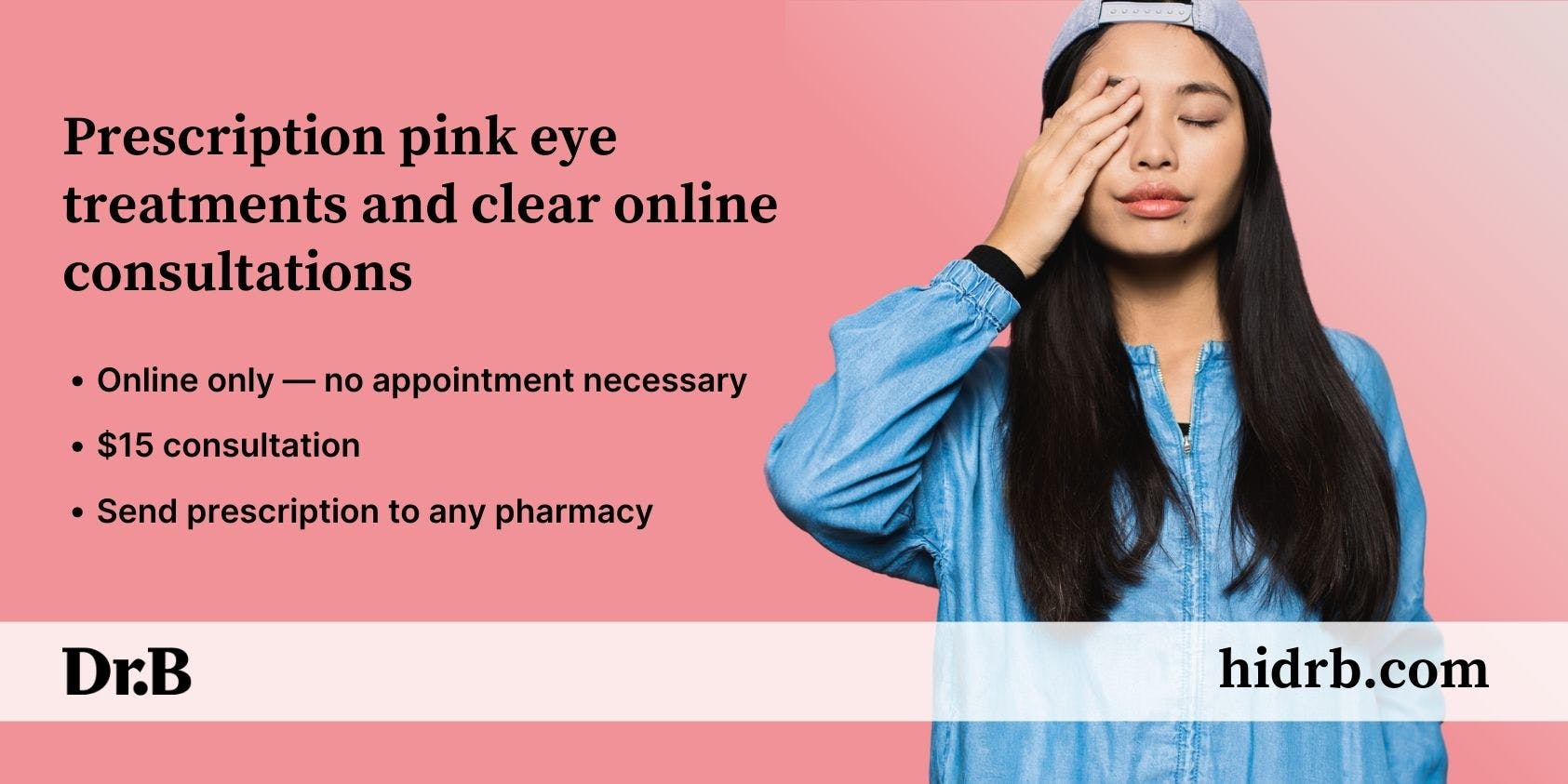
How long is pink eye contagious after starting drops?

Key Points
- Pink eye (or conjunctivitis) can be caused by viruses, bacteria or allergies.
- Conjunctivitis usually gets better on its own. But antibiotic eye drops can help treat bacterial conjunctivitis.
- Pink eye is very contagious. If your eyes are actively tearing or have discharge, it’s best to stay home.
So you've got the red eyes, tenderness and delightful eye crustiness of classic pink eye! The burning question on your mind—aside from the burning in your eyes—is probably about when you can get back to work or school.
Pink eye can spread quickly—especially in daycares, classrooms and workplaces. So you’re contagious as long as you’re having symptoms like eye discharge or redness. Below, we share the symptoms, contagiousness and treatment options for this super-common eye ailment.
And if you need prescription pink eye treatment ASAP? Dr. B is here to help with a convenient, same-day pink eye consultation.
What is conjunctivitis (pink eye)?
Conjunctivitis is an irritation of the outer layer of the eye. It’s very common in children, but adults can also develop pink eye.
Symptoms of pink eye include:
- Itchy, watery eyes
- Watery or crusty discharge from the eye
- Redness of the sclera (the white part of the eye)
- Eyes that are sensitive to light
- Burning or irritation in the eye
- A gritty, sandy feeling in the eye
- Waking up with eyes crusted over
- Tenderness around the eye
What causes pink eye?
Pink eye can be caused by an infection or by an allergy. It’s important to have the cause of your pink eye diagnosed, as this can impact your treatment plan.
Viruses: Viruses are the most common cause of conjunctivitis. You might develop pink after an upper respiratory infection like the common cold. The most common symptoms of viral conjunctivitis are watery eyes and mild eye itching. These usually start in one eye and spread to the other eye in a day or two. Antibiotics won’t help viral pink eye.
Bacterial: Bacterial pink eye is caused by an infection with bacteria. A classic sign of bacterial pink eye is waking up with both eyes crusted over. Other common signs of bacterial conjunctivitis are eye grittiness, feeling like there’s something in your eye and yellowish eye discharge. This type of pink eye can be treated with antibiotic eye drops or ointment.
Allergies: Allergic conjunctivitis happens when allergens like pollen or dust irritate the eyes. They usually cause redness in both eyes. Plus a little pain, lots of eye itching, and stringy, watery eye discharge. This type of pink eye responds best to allergy medications and artificial tears. It’s also important to avoid your allergy triggers to help your symptoms go away.
How long does pink eye last?
How long pink eye lasts depends on what’s causing your symptoms. Allergic conjunctivitis generally gets better when the allergen is removed. Viral pink eye usually goes away by itself in a week or two.
Bacterial conjunctivitis often gets better on its own in two to five days. But antibiotic eye drops or ointment can help you recover faster. Without treatment, bacterial conjunctivitis can last several weeks.
Pink eye is contagious as long as you have symptoms. The germs that cause conjunctivitis are spread by coughing or touching something that has the germs on them. If you have tearing, discharge or crustiness in your eye, you can spread the illness.
When to see a doctor
Pink eye usually gets better on its own without any special treatment. It’s normal to have a little pain in your eyes when you have conjunctivitis. But the pain shouldn’t be severe. So watch out for warning signs like extreme pain or swelling, fever or changes in vision. If moderate symptoms last longer than three days—or if your symptoms become severe—see a medical provider. In rare cases, the infection can spread to other parts of the eye.
You might also notice some blurred vision. But this should go away when you wipe the discharge out of your eyes. If your vision is very blurry no matter what you do—or if you can’t open your eyes because of light sensitivity—get help right away.
Can I go to work with pink eye?
Allergic conjunctivitis isn’t caused by a germ. So pink eye from allergies isn’t contagious.
But viral and bacterial pink eye are highly contagious. So if you have active symptoms—like tearing or eye discharge—it’s best to stay home. This is especially important for food handlers or healthcare workers. And if you have a fever or sore throat, it’s important to stay home until you’re feeling better.
If your symptoms are on the mend, it’s okay to go back to work or school. Just be sure to practice good hygiene so you don’t spread the illness.
You can do so by:
- Washing your hands frequently
- Avoiding touching your eyes
- Covering any coughs or sneezes with a tissue or your elbow
- Not sharing make-up, towels or bedding
- Not swimming in public spaces
At-home remedies for pink eye
Several at-home treatments can help you feel better while you recover from conjunctivitis.
- Wipe your eyes with a warm, wet washcloth
- Use artificial tears to relieve dryness
- Apply a cool or warm compress to relieve pain and swelling
If your eyes are red or if you have drainage, don’t wear contact lenses. Always wash your hands before and after touching your eyes.
Prescription treatments for pink eye
Antibiotic eye medications can help treat bacterial eye infections. The most common medications for bacterial conjunctivitis include:
These medicines cause fewer side effects than oral antibiotics. But they do need to be used several times a day for up to ten days. You can get prescription pink eye medication from your medical provider or an urgent care clinic.
And if you can’t see your provider? Dr. B offers convenient, online pink eye treatments. Just fill out a short health questionnaire about your symptoms and health history to get started. A licensed provider will review your information within three hours. If appropriate, they’ll send a pink eye prescription to your pharmacy of choice!
Sources
Centers for Disease Control. (2022). Conjunctivitis: treatment.
Centers for Disease Control. (2022). Conjunctivitis: causes.
Cronau, H., et. al. (2010). Diagnosis and management of red eye in primary care. American Family Physician.
Patient information. Pink eye: what you should know. (2010). American Family Physician.
Sign up for the free Dr. B newsletter for a weekly report on the latest in healthcare + research-based advice for staying healthy and mentally well.


